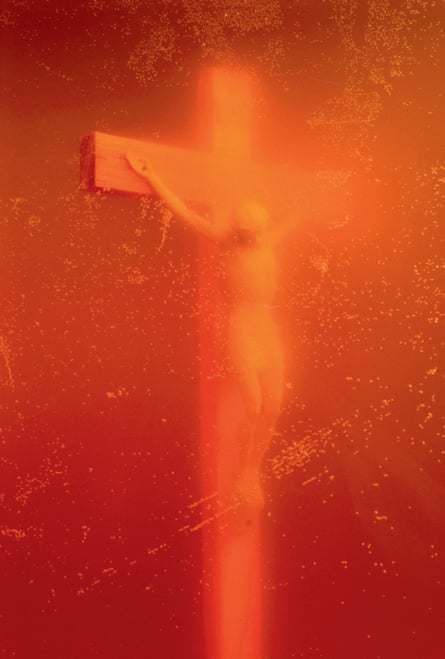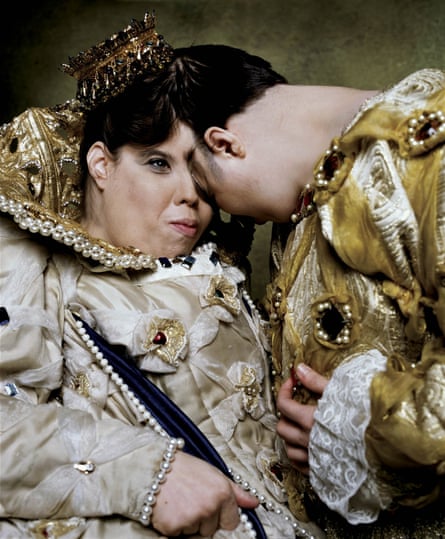Andres Serrano has a reputation for outrage, so the postcard he is holding face down against his chest as we share the closest thing London has to a New York brunch must be strong stuff. Is it a photograph of a shocking sex act, a broken body, a desecrated Christian symbol? He explains that he has never shown this picture before, but decided he had to include it in his new retrospective in Brussels. It is a portrait of Donald Trump.
The shocking thing is that it is not an aggressive, satirical image of the strangest ever contender for the US presidency. It is a straight, close-up portrait that Serrano shot for a series called America, in which he tries to capture the face of his nation. After 9/11, he felt he and all Americans were seen by the attackers as the enemy. “I wanted to show who the enemy are,” he says.
I fulminate against Trump in fairly predictable ways. “You know, Jonathan,” he says, “I never speak ill of people who’ve posed for me.” Serrano (and I admit this is isn’t a critic-like thing to say) is one of the nicest artists I’ve ever met. He radiates humour and kindness. He can even see the human in Trump. His portrait is like a waxwork image of a powerful man, glaring enigmatically at the camera.
And yet few artists have a more diabolical reputation. Serrano’s art gets attacked, verbally and physically. His most famous work, Piss Christ, a photograph of a plastic crucifix in a glass of his own urine, is still being targeted decades after it was created: in 2011 in Avignon, a print got slashed by religious protesters, who also destroyed a Serrano photograph of a meditating nun. Yet here he is, radiating good will. For Serrano – much as it might shock his conservative Christian detractors – is a spiritual artist, whose Catholic vision of suffering humanity echoes the great baroque painters.

Alongside his exhibition in Brussels, he is showing photographs of homeless people he took in the Belgian capital and New York. They resemble his portrait of Trump – calm, compassionate, almost sculptural images that have the dignity of 17th-century portraits by Jusepe de Ribera. One, Daniel Angelice, has a cigarette under his yellow flowery bedding near a Brussels metro station. Muhammed Haddoul gazes sadly out of his castle of cardboard boxes. The day after the exhibition opened, Brussels was bombed.
There’s nothing arbitrary about comparing Serrano with Spanish and Italian Catholic artists of the baroque age. He loves baroque art so much that he has filled his New York home with it. “At least I know where my money’s gone,” he says. Among the treasures in his Hammer horror-style hall is a hyperrealistic 17th-century Spanish sculpture of the severed head of John the Baptist, with blood seeping from the neck. “I see myself as belonging to a tradition of religious art going back to Caravaggio and others,” he says. “Caravaggio’s works are so strong – using a prostitute as the Virgin Mary ...”
Baroque art tries to shock and awe its audience, to awaken the flock from slumber with art that tells the Christian story with raw power. But its ultimate aim is to release the compassion in our hearts. It seems appropriate that Serrano’s images come from the streets of Brussels. These are sympathetic, humane pictures: Koki Amaaea smiles in his sleeping bag under a modernist portico, not objectified by the camera but embraced visually by Serrano as a fellow human being.
The passion of Serrano’s art is at its bravest in Piss Christ. In 1989, two years after he made it, a national scandal exploded in America when Jesse Helms, a Republican senator, used Piss Christ – along with the sexually explicit photographs of Robert Mapplethorpe – to condemn the National Endowment for the Arts for using public money to promote blasphemy and filth.
Yet Piss Christ is not a blasphemous provocation at all, Serrano insists. On the contrary, it is a serious work of Christian art, from a self-confessed sinner whose belief is anything but prissy. “What it symbolises is the way Christ died: the blood came out of him but so did the piss and the shit. Maybe if Piss Christ upsets you, it’s because it gives some sense of what the crucifixion actually was like.”

Christian art has often dwelt on the goriest aspects of the crucifixion, not merely to shock but to humanise Christ. In Grünewald’s Isenheim Alterpiece, the emaciated body of Christ is covered in sores and pus and is turning green as he hangs on the cross. The truly strange thing about Piss Christ is the distance it places between us and the dying man. He is small and remote, in a glowing red sea of urine. He looks as isolated as a Francis Bacon pope. This is an image of Christ as seen by a man who was, in 1987, rediscovering a childhood faith he had long neglected. It comes as no surprise to learn that Serrano loves the films of Buñuel and Fellini. “You can see with those guys that there’s a religious Catholic element,” he says, “even when they try to get away from it.”As for his own position, he says: “I was born and raised a Catholic and I’ve been a Christian all my life. When I was eight years old, I made my holy communion. When I was 12, I made my confirmation, and then I stopped going to church for about 20 years.”
Serrano was born in Manhattan and grew up in Williamsburg, Brooklyn, in a strongly Catholic environment, although he gets upset when people misunderstand his cultural roots. “I’ve been called Puerto Rican, Asian and Cuban – people can’t just say, ‘An artist born in New York City.’ My mother was born in Florida and raised in Cuba. She’s American and I’m second-generation American.”
Serrano has seen the dark side of life. And I don’t just mean what he worked in advertising for a while. He has done worse. “I have to confess, when I became known as a controversial artist, I was afraid because I thought, ‘Wow, if they think a work of art is controversial, what if they knew about all the things that I’ve done in my life?’ Because after art school, from the time I was 19 until 28 – it was an era of experimentation – I was on drugs and living in the East Village, selling drugs on the street.”
Only when he hit his late 20s did he realise it was time to clean up and get back to making art – if he’d carried on into his 30s, he thinks there would have been no escaping. This could of course be one of the things that gives his work such a dark haunting quality, an authentic, avant-garde dirtiness. And that’s Catholic, too – for, as he reminds me, you can’t have good without there being evil.

Serrano’s most profound reinterpretation of baroque art is a cycle of close-up photographs of the dead, called The Morgue. He was allowed to take these portraits in an unnamed US morgue on the understanding that none of the subjects would be recognisable. So we see in one a wide-open eye peeping out of a head swathed in cloth; in another, a burns victim’s charred hand.
“It was a spiritual quest,” Serrano says. “When I got to the morgue, I learned that people don’t know what kind of death is in store for us. It’s not the death you thought you’d have or the one you deserved. Most of the people who ended up in the morgue died in horrible accidents, suicide, murder and terrible diseases. Very rarely did I encounter somebody who died of old age. I always felt they were alive in some way. There was a soul to each individual.”
These pictures are far more shocking, I think, than works like Piss Christ. These direct confrontations with dead human beings are truly upsetting – look them up online if you have a strong stomach. They stay with you, and not in a good way. I felt I had seen too much. Then I remembered that Caravaggio painted a dead prostitute as the Virgin Mary, revealing the absolute and unavoidable reality of death; and how Holbein painted the dead Christ in the tomb, rotting, eyes wide open. To make us see death is one of art’s most serious jobs, and Serrano performs it masterfully.
- Andres Serrano: Uncensored Photographs is at the Royal Museums of Fine Arts, Brussels, until 21 August.

Comments (…)
Sign in or create your Guardian account to join the discussion